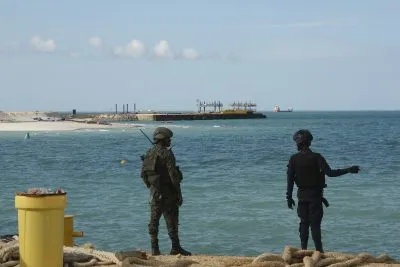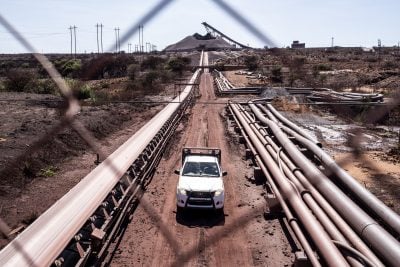Water shortages are one of the inevitable consequences of intensifying climate change. Rising temperatures and more frequent and prolonged droughts are increasingly jeopardising access to the most fundamental ingredient of life across large swathes of Africa. In fact, around one third of Africa’s population is already affected by water scarcity, according to the World Health Organization.
An assessment by the United Nations University last year found that 13 African countries, mainly in the Sahara and Sahel regions, are “critically water insecure”. The situation will worsen in the years ahead, as population growth and more intensive development of coastal areas add to the challenges linked to climate change. More African cities can expect to face situations akin to the crisis in Cape Town in 2018, when the city famously came close to “Day Zero”, when mains water would cease to flow. It is no surprise, therefore, that Africa is paying more attention to desalination technologies – in which salty water (usually seawater) is made drinkable.
Desalination most commonly uses the process of reverse osmosis, in which water is forced through a membrane at high pressure to filter out salt and other unwelcome elements. Desalination is already widespread in some water-stressed parts of the world. The Gulf region boasts around 400 desalination facilities: Kuwait, for example, receives up to 90% of its drinking water from the technology. Desalination is, however, an expensive process, and it comes with significant environmental side effects. Africa faces a major challenge in making greater use of desalination, while finding ways to mitigate its more damaging outcomes.
Decentralising desalination
One of the main drawbacks of desalination is that the process uses huge quantities of energy. This is one reason why desalination is far more expensive than more traditional methods of treating water. And, if fossil fuels are used to power desalination facilities, then desalination will end up worsening climate change – the very problem that is driving the increased use of desalination in the first place. On top of this, the waste products from desalination – which are concentrated in a very salty residue known as brine – have to be disposed of somehow. When brine is released back into the sea, it can cause significant damage to marine plants and animals.
But some developers claim to have found ways to mitigate these problems, especially in smaller-scale desalination projects. Dutch company Elemental Water Makers operates in around 10 African countries. Its co-founder and managing director, Sid Vollebregt, says that the company’s facilities use 70% less energy than conventional designs and are powered by solar panels. The company also produces a more diluted brine, then reuses brine in its energy recovery process, which helps reduce its energy requirements. Vollebregt explains that smaller-scale, solar-power desalination facilities are particularly suitable for remote areas.
“We do relatively small-scale desalination for decentralised regions,” he says, adding that the company typically operates where grid electricity is either expensive, unreliable or completely unavailable.
The deployment of off-grid solar-powered desalination facilities mirrors the trend in Africa’s electricity systems, in which private solar projects are increasingly used as a back-up to unreliable grid electricity, or to extend electricity access to areas entirely unserved by the grid. Elemental Water Makers, for example, provides desalination to a mix of customers, including both NGOs that are working to provide more reliable water access to remote communities, and coastal properties such as tourist resorts that would otherwise struggle with a reliable water supply. The company currently serves around 50,000 people, but Vollebregt says that it aims to reach 10m by 2030. This reflects the reality that Africa’s water needs are increasing just at the time that climate change is reducing available supply.
“Africa is a booming continent,” Vollebregt points out, noting that coastal tourism is burgeoning in many areas and that resorts need to ensure a reliable water supply. Greater use of desalination is inevitable, he suggests.
“Where there are no other options, desalination will become a bigger part of the solution.”
Investor interest Indeed, alongside decentralised projects, a growing number of large-scale desalination facilities are on the drawing board. After Cape Town’s narrow escape from “Day Zero”, South Africa began to pay more serious attention to expanding desalination. The country’s Water Partnership Office is preparing a tender scheme to attract private-sector investment If fossil fuels are used to power desalination, then it will end up worsening climate change – the very problem driving its increased use in desalination, modelled on the relatively successful independent power producer scheme in the renewable energy sector.
Meanwhile, several large projects are under development in North Africa. Spanish company Acciona was awarded a contract last November to lead the construction of what will be the continent’s largest desalination facility in Morocco. The €800m scheme near Casablanca, which Acciona will build alongside two local firms, is designed to produce 300m cubic metres of water a year by 2030.
Investors, particularly development finance institutions (DFIs), are increasingly looking at desalination in Africa as a means to contribute towards the Sustainable Development Goals on water access. British International Investment, the UK’s DFI, noted in a 2022 report that the sector is “on the cusp of an impact inflection point,” due to the growing possibility of meeting desalination’s energy requirements with renewable sources. However, the report acknowledged that desalination’s “costs and benefits are both high,” meaning that investors need to ensure desalination is prioritised only after considering alternatives and maximising environmental mitigations.
No panacea
There is a long way to go before desalination becomes widespread across the continent.
“Reverse osmosis is still an emerging technology in Africa,” says Betty Ojeny, a water, sanitation and hygiene (WASH) governance advisor for Oxfam in Africa.
“There is very limited private sector capacity and technical expertise to supply or service and maintain equipment.”
Ojeny tells African Business that Oxfam is still in the early stages of utilising desalination, focusing for the time being on small pilot projects in sub-Saharan Africa. While the technology is “novel, high tech and unfamiliar” for most countries on the continent, she says that Oxfam’s cost analysis indicates that treating saline water can be significantly cheaper than transporting fresh water by tanker across vast distances. She emphasises, however, that new models will need to be developed to ensure that small-scale projects in rural areas can function economically.
“A traditional community-owned and communitymanaged system has a very high chance of failure,” she says, adding that private sector schemes that provide incentives for good performance are preferable.
On the other hand, Ojeny cautions that “private sector management is not a silver bullet.” A private sector operator will need to work closely with local stakeholders to gain community buy-in, she argues. Given the reality that such projects serve low-income communities, operators will also need to have motivations other than maximising profits, Ojeny says.
Ultimately, desalination is only one part of the solution. For obvious reasons, the technology is generally suited for coastal areas – although desalination can also be used to produce drinking water from saline inland aquifers. But with the impacts of climate change more apparent with every passing year, there is little doubt that desalination will play an increasingly important role in sustaining Africa’s drinking water in the decades to come.
Want to continue reading? Subscribe today.
You've read all your free articles for this month! Subscribe now to enjoy full access to our content.
Digital Monthly
£8.00 / month
Receive full unlimited access to our articles, opinions, podcasts and more.
Digital Yearly
£70.00 / year
Our best value offer - save £26 and gain access to all of our digital content for an entire year!
 Sign in with Google
Sign in with Google 



